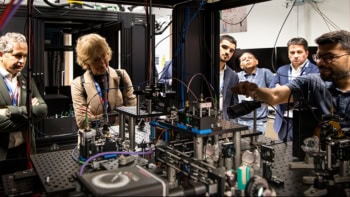
Physicists have discovered a new quantum state in a material with the chemical formula Mn3SiTe6. The new state forms due to long-theorized but never previously observed internal currents that flow in loops around the material’s honeycomb-like structure. According to its discoverers, this new state could have applications for quantum sensors and memory storage devices for quantum computers.
Mn3SiTe6 is a ferrimagnet, meaning that its component atoms have opposing but unequal magnetic moments. It usually behaves like an insulator, but when physicists led by Gang Cao of the University of Colorado, Boulder, US, exposed it to a magnetic field applied along a certain direction, they found that it became dramatically more conducting – almost like it had morphed from being a rubber to a metal.
This effect, known as colossal magnetoresistance (CMR), is not itself new. Indeed, physicists have known about it since the 1950s, and it is now employed in computer disk drives and many other electronic devices, where it helps electric currents shuttle across along distinct trajectories in a controlled way.
The thing that differentiates the insulator–CMR transition Cao and colleagues observed is the mechanism behind it. In Mn3SiTe6, this transition is driven by internal loops of current with a specific handedness, or chirality, that form within the material’s octahedral structures. Cao explains that these internal currents are extraordinarily susceptible to external currents, which disrupt and eventually “melt” the loop currents. The result is a transition to a different quantum state via a mechanism rather like the transition from solid to liquid.
Long-term stability
“Such a transition takes seconds or minutes to occur because the loop currents extend over multiple atomic sites that allow the new quantum to remain metastable over strikingly long time scales,” Cao reports. “This stability is set by atomic motion rather than by electrons alone, which would make the transition otherwise occur much quicker, on the order of picoseconds.”
Mn3SiTe6’s CMR behaviour makes it an intriguing exception to more common CMR patterns, Cao adds. “In this material, CMR only occurs when magnetic polarization is absent,” he tells Physics World. “The phenomenon we observed defies all existing theoretical models and experimental precedents.”
According to Cao and his colleagues, in the absence of a magnetic field, the loop currents in Mn3SiTe6 tend to remain disordered, flowing in both clockwise and anticlockwise directions. Cao compares this effect to cars driving through a roundabout in both directions at once, and says that the resulting disorder causes “traffic jams” for electrons travelling in the material, increasing the resistance and making it an insulator.

Ferrimagnets speed up racetrack memories
“In the presence of a magnetic field, however, the loop currents will begin to circulate only in one direction, which creates an ordered state,” he continues. “The traffic jams disappear and the electrons can propagate through the material with drastically reduced electron scattering as if it was a metal wire.”
In Cao’s view, the newly-discovered quantum state raises many fundamental questions yet unanswered. However, he suggests that the extraordinary susceptibility of the new quantum state to small external currents, along with its controllable, time-dependent switching, could offer a paradigm for quantum devices such as memories and sensors.
For now, the effect has only been observed at low temperatures, but Cao and colleagues are now searching for materials that show the same behaviour at higher temperatures. “No quantum state exists only in one particular material,” Cao says. “The quantum state we have observed should therefore not be an exception.”
The research is detailed in Nature.



